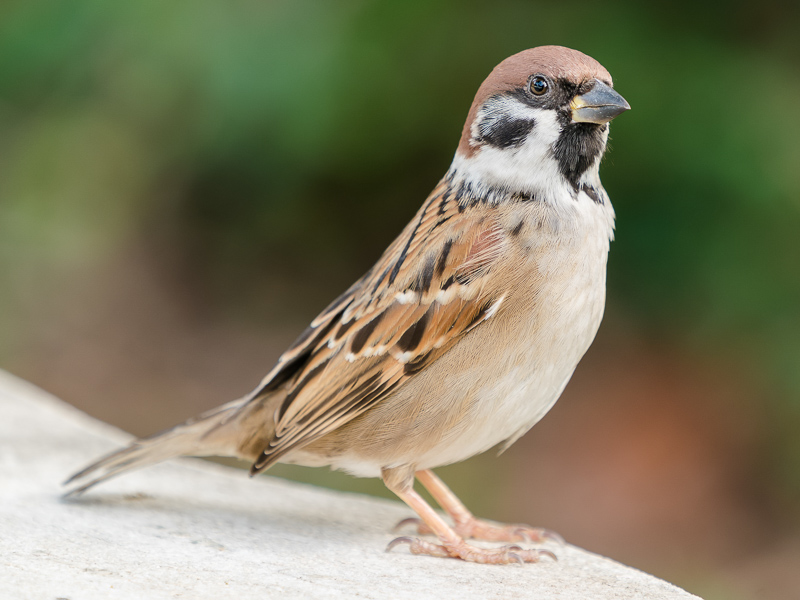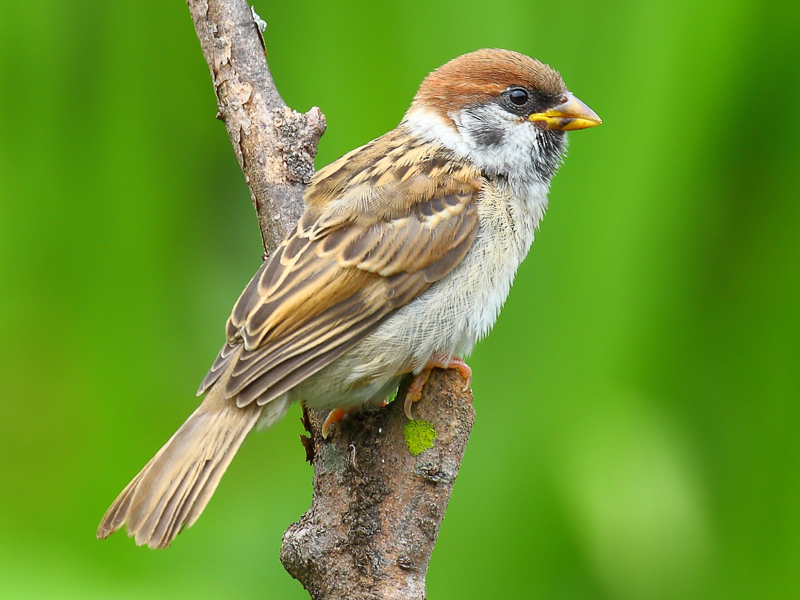Eurasian Tree Sparrow Passer montanus 樹麻雀
Category I. An abundant resident, commensal with humans and found in all lowland anthropogenic habitats, especially in active farmland, around fish ponds and in city parks.
IDENTIFICATION

May 2020, Kenneth Lam.
A rather plump short-tailed passerine with strongly patterned upperparts with two white wing bars and plain buffy underparts; sexes alike. Distinguished from males of two similar sparrows which are rare visitors to HK by its combination of a chestnut cap and a white cheek with a black spot (though this black spot can sometimes be rather obscure in recently-fledged juveniles).

May 2020, Kenneth Lam.
The black spot on the cheek can sometimes be rather obscure in recently-fledged juveniles, and the bill may be variably yellow.
VOCALISATIONS
The song is a simple repeated chirp.
Calls of anxiety or alarm are shorter, drier and often rapidly repeated.
DISTRIBUTION & HABITAT PREFERENCE
In HK Eurasian Tree Sparrow is commensal with people and is found in all urban, suburban, village, industrial, open storage and farmland areas. It is most abundant where food is accidentally or deliberately provided by people including in city parks, active dry agricultural land, around livestock and active fish ponds where large flocks can be seen feeding on bread or noodles provided as fish food. It is absent from forest, shrubland and upland grassland, and also from uninhabited islands. A population on the Soko Islands (which seems to have been colonised at some point after a detention centre was established there) disappeared after the centre was closed (Carey et al. 2001). On Tung Ping Chau there was a population in the village when it was permanently inhabited, but after people stopped living there, it had lost its Eurasian Tree Sparrow population by the time of the second atlas surveys in 2016-19. On Po Toi, it is primarily a passage migrant and only an occasional breeding bird though it is not clear if this represents a change. At Pak Sha O, Sai Kung, which comprises fewer than 20 residents in traditional Hakka buildings, Eurasian Tree Sparrow occurred on only two occasions in ten years from 2012.
Eurasian Tree Sparrow was recorded in 49.6% of squares during the first breeding atlas survey of 1993-96 and 37.0% of squares in the first winter atlas survey of 2001-05. In the 2016-19 surveys it was found in 39.3% of squares in the breeding season and 37.7% in winter. Because of methodological differences between the first breeding season survey and subsequent surveys it is probably not wise to read too much into the apparent decline at this time.
The population estimates obtained by annual Eurasian Tree Sparrow surveys in May from 2016 to 2023 are provided in Table 1. Full details have not been published as yet, but it seems that highest densities of individuals were found in residential, village and recreational areas.
Table 1. Estimated population of Eurasian Tree Sparrow Passer montanus in Hong Kong (Source: HKBWS).
2016 | 2017 | 2018 | 2019 | 2020 | 2021 | 2022 | 2023 |
306,000 | 307,000 | 257,000 | 243,000 | 266,000 | 211,000 | 287,000 | 243,000 |
Since the time of Swinhoe (1861) most observers have described Eurasian Tree Sparrow as abundant throughout HK, though Herklots (1953) considered that it was rarely seen in open country except when the rice crop was ripe, suggesting that it was rather more localised in the New Territories in the 1930s than it is today. Certainly its presence in fish pond areas is likely at least partly related to the occurrence of spilt fish food.
OCCURRENCE
Carey et al. (2001) suggested that there was no evidence of regular migration in HK. However, whilst no doubt the majority of individuals are sedentary, regular and systematic coverage on Po Toi during 2006-12 (Welch 2014) showed that the population there is migratory. It is primarily a spring passage migrant from early April to early June, with two or three pairs remaining to breed in some years; smaller numbers pass through in autumn from August to November and it is entirely absent in winter. Numbers vary, with large flocks occurring in some years, especially in mid to late May; the highest count was of a flock of 230 on 31 May 2008. Nothing is known of their origins or destinations, but migration has been observed elsewhere in China. As noted by Welch (2014), La Touche (1912) recorded small flocks on islands off Shanghai between late March and early May, a pattern of occurrence dates similar to that seen on Fair Isle, Scotland. Migrants observed at Po Toi are often found in flocks, either around the village or the lighthouse in the south of the island (Welch 2014). Perhaps, some of the flocks observed at such sites as Long Valley and the Deep Bay fish ponds are also made up of migrants, but there is no firm evidence of this.
BREEDING
The breeding season in HK extends from March to August, with up to three broods raised. The nest is an untidy ball made of grass and pine needles lined with feathers (Herklots 1953) and is usually placed on buildings or, less often, in a bush or small tree. Four or five eggs (19 x 14mm in size) are laid; these are rather variable in colour but are usually greenish-grey with fine mottling tending to form blotches (Herklots 1953).
BEHAVIOUR, FORAGING & DIET
In HK Eurasian Tree Sparrow is usually to be found in small flocks of up to 20 or 30 birds foraging on the ground or in grass clumps or perched in often noisy groups of a similar size in bushes or on buildings and utility structures. Larger aggregations of up to around 200 birds are sometimes found at sites where food is abundant such as at Long Valley when the rice crop is ripe, or at piles of food provided as fish food around fish ponds. Other than those counted in the HKBWS surveys described above, the largest count on record is of 515 birds in Long Valley on 11 August 2015.
Eurasian Tree Sparrow is primarily a granivore. Whilst, as was noted by Herklots (1953), it is attracted to ripe rice, this is now only grown in small quantities in HK and birds now forage on grass seed or consume bread and dried noodles and other scraps accidentally or deliberately provided by people.
RANGE & SYSTEMATICS
Widespread across the Palearctic Region south of the Boreal Zone and the Oriental Region except for most of the Indian subcontinent (Barlow et al. 2020). Occurs throughout China except for much of Tibet and desert regions of Xinjiang (Liu and Chen 2021).
There are nine races, no fewer than seven of which occur in China. Six of these are found in the west and north of the country, whilst those in south China, including HK, are P. m. malaccensis.
CONSERVATION STATUS
IUCN: Least Concern. Population trend decreasing.
Barlow, J. C., S. N. Leckie, P. Pyle, and M. A. Patten (2020). Eurasian Tree Sparrow (Passer montanus), version 1.0. In Birds of the World (S. M. Billerman, Editor). Cornell Lab of Ornithology, Ithaca, NY, USA. https://doi.org/10.2173/bow.eutspa.01
Cheng, T. H. (1987). A Synopsis of the Avifauna of China. Science Press, Beijing.
Herklots, G. A. C. (1953). Hong Kong Birds). South China Morning Post, Hong Kong.
La Touche, J. D. D. (1912). List of species on the island of Sha Wei Shan. Bull BoC 24: 124 – 160.
Liu, Y. and S. H. Chen (eds) (2021). The CNG Field Guide to the Birds of China (in Chinese). Hunan Science and Technology Publication House, Changsha.
Swinhoe, R. (1861). Notes on the ornithology of Hong Kong, Macao and Canton, made during the latter end of February, March, April and the beginning of May 1860. Ibis 1861: 23-57.
Welch, G. (2014). Observations on the migration pattern of some commoner landbird migrants: Po Toi 2006-12. Hong Kong Bird Report 2012: 278-294.

